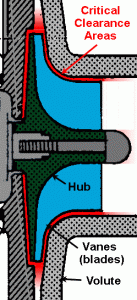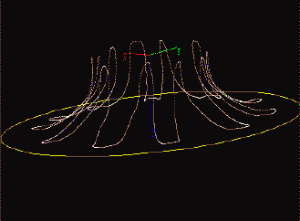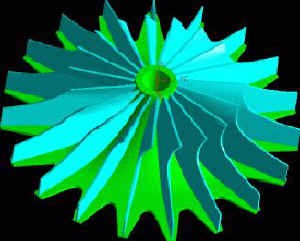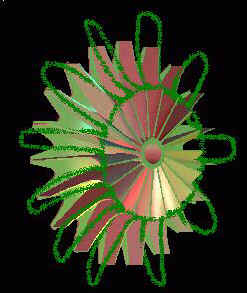High Speed Centrifugal Compressor
Reverse Engineering
Industrial Case Studies
High Speed Centrifugal Compressor
| — The problem — This compressor was a very high speed, high output unit, specifically custom designed for the application it is used in. These factors were also the driving reasons for its very large price tag. Another condition in this equation was its age. The OEM that manufactured the blower was no longer supporting the unit, and therefore had no spare parts available. | |
 | Lets add the clincher to this disturbing yet very common situation. And this, as they say, “is where the plot thickens”. Upon disassembly, the destroyed compressor wheel, the obvious reason for the unscheduled outage, was removed from the unit. There was another used wheel in the warehouse that had previously been removed from service because it too had worn beyond its ability to produce the required pressure, but had been replaced before it was completely destroyed, as was the case with the failed wheel. They were contemplating whether or not they might use the worn spare wheel to try to squeak by until they could get an OEM replacement, when someone made a grim discovery. The mating wear surface of the volute was worn over .125 of an inch (more than twice the total running clearance of.059″), so now not only was there no hope of making adequate pressure with the worn wheel, but even with a brand new OEM wheel, they would not be able to get the pressure that the unit was designed to produce. |
| The volute assembly was so large that just removing it would cost a tremendous amount of man hours, then there would be shipping and substantial repair costs, and the labor to reinstall. The chances of a repair being successful, without the proper engineering geometry of the involute curve on the blade edges and the wear surface of the volute itself, was very poor indeed, and extremely expensive. This was a risk and expense that just could not be justified. | (Digitized points from worn volute) |
| (New surface geometry for blade edges)
| — The Answer — The answer was to go to the customers site and accurately digitize the worn surface of the volute. The Laser Tracker was the logical choice, as it had both the portability and accuracy needed to successfully acquire the data. We then take that reverse engineered surface and make a new wheel that will precisely fit the worn volute, thereby maintaining the running clearances and the factory fresh performance of a new machine.
|
| The term “match machining” means to machine one part to match the profile of the mating part that it will operate with. This is often the best and sometimes the only way to insure a complete and correct fit between parts, especially when the tolerances are tight and the profile is complex. Digitizing one part allows us to use precision manufacturing techniques to insure the mating part will function as intended. After digitizing the volute and match machining our newly manufactured wheel to fit the wear in the mating volute surface, the high speed / pressure compressor functioned as well as a new unit, saving the customer tens of thousands of dollars not having to buy a new unit. And substantially more money than the initial purchase savings in not having to wait months for a new unit to be designed and manufactured, all the while losing many thousands of dollars in profit for every day that the unit was down. This high speed high accuracy method of reverse engineering and manufacturing has literally saved some of our customers from going out of business due to the loss of their mission critical components (down time), and the lengthy lead time of the OEM’s in getting a replacement or re-manufactured unit back to the customer. This is thevalue-add of our services that cannot even be quantified in just monetary savings, saving jobs and even entire companies is a satisfaction that goes way beyond just liking what we do, and our customers are extremely pleased with the results. | |
Finished CAD model

